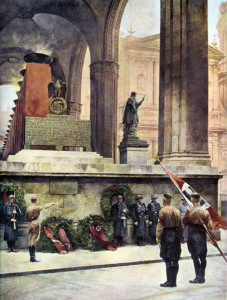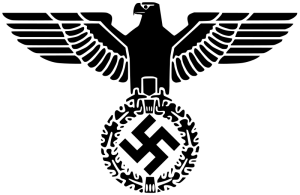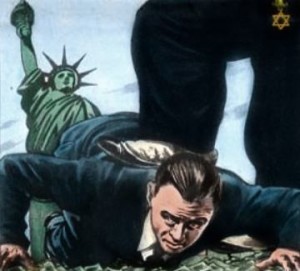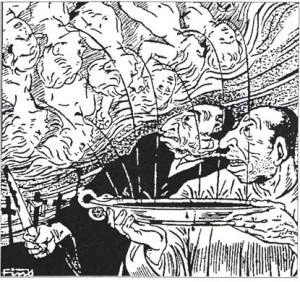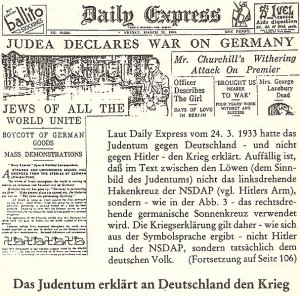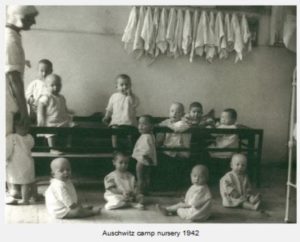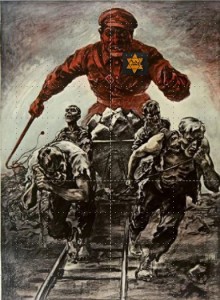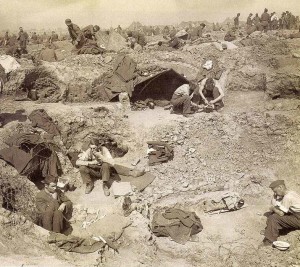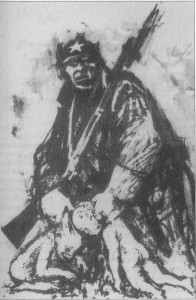germanvictims.com - In order to justify these rape, rob and murder programs planned long ahead in many eastern countries, the Germans had to be represented as evil in the press. By heaping a false holocaust on them, they could be suppressed with laws to keep silent and their children were made to believe the lies. This way a great competition, the Germans, was cut out of the market.
By Admin
Question: Since all white people are from the same Germanic stock, and if the International Criminal Gang wants to eliminate the Germans in Germany from the playing field because they claim that the Germans are inherently evil and keep “proving it” with their holocaust and war crime inventions through their ever screaming media power, what will eventually [so far it’s been a slow erosion process so that we would not notice] happen to white people anywhere in the world? [Just look at the white minorities in South Africa where the savages cut open the white people’s bellies alive and rip out their intestines.] Who is instigating and feeding this hate against the white farmers? Who is NOT controlling these crimes? It would have to be the media since the white farmers are not doing anything against the black natives and never have. The white farmers in South Africa are of German and Dutch stock. Is this another genocide instigated by those who hate all people against the German people?
Allied Plans for the Annihilation of the German People
- Measures for the Devastation of the Heart of Europe -
Claus Nordbruch
Long before the outbreak of the Second World War, and certainly long before the outcome of this European slaughter of brothers was foreseeable, the victors-to-be and their hangers-on had made plans for the disposition of Germany that contained fundamental violations of the Law of Nations. In addition to demilitarization and de- nazification projects there were plans for the destruction or expulsion of Germans from territories they have had inhabited for many centuries. For example, the expulsion of three and a half million of the Sudeten Germans was proposed in December 1938 by later Czechoslovakian president Edvard Beneš, that is, nearly a year before the official outbreak of the war - and he was not the first to make the proposal. During the Pan Slavic Congress held in Prague in 1848 the decision was taken that not only Sudeten Germans, but all ethnic Germans east of the line Triest-Stettin should be driven out. In summer 1917 Beneš and later president Minister-President KramáÅ™ gave the Allies a memorandum in which they demanded the dismemberment of Germany and the incorporation of large territories of the German Empire and Austria-Hungary in the Czechoslovakia that was to be formed.[1] After the signing of the dictate called the “Versailles Treaty,” nationalistic Czech and pan Slavic statements and demands were politically prominent; unfortunately there is not space here to discuss that subject in detail.[2] However, these demands were all more or less fanatically fixed on the expulsion of the Sudeten Germans.
These projects in violation of the Law of Nations were by no means merely the extravagant thoughts of chauvinistic, pan Slavic or Communist politicians: they were the official policy of national governments. The preamble to the Atlantic Charter expressly granted Czechoslovakia the proviso that, on the signing of the document, the expulsion of Germans could not be hindered. In September 1942 Beneš, ironically president of the National-Socialist Party, which after the war renamed itself the “People’s Socialist” Party, received support for his plans from the English government. London communicated that it had no objection to the deportation of the Sudeten Germans, a population that has been dwelling in what is now Czechia as long as the Czechs themselves. In May 1943 Beneš received a similar communication from Roosevelt and in June 1943 another from a Soviet liaison man in London, Alexander Bogomolov. In fact, the Czechs, and especially Beneš, had never intended to subject the goal of a de- Germanized Czechoslovakia to international supervision or even to any criteria of humane conduct. In July 1944, a notice from high authority was circulated in the Czech resistance to the effect:[3]
“We consider the possibility of the transfer of our German population. It can not be definitively stated that three millions of Germans in all can be transferred subject to some kind of international regulation. […] It is necessary that in the first days of liberation we ourselves remove many and that as many as possible guilty Nazis fly before us out of fear of a civil revolt against them in the first days of the Revolution, and that as many as possible who resist as Nazis and defend themselves be struck down by the Revolution.”
After the military capitulation it was no longer necessary for the Czechs to operate conspiratorially and they professed their bloody intentions publicly. On 31 May 1945 the Czech National-Socialist newspaper Slovo národa stated drily:[4] “It will not be permitted for citizens of German descent to mingle with the Czech population.”
We should add to this remarkable announcement that it has been shown that the Czech exile government under Beneš worked single-mindedly for ethnic cleansing in what was to be a newly formed Czech Republic, and that this has been carried out in a manner disregarding human rights and against the Law of Nations, as will be shown below.
Even in Poland they dreamed of expansionist plunder raids and fantasized about Polish extension to Stettin and even to Berlin, and this long before September 1, 1939. The official program of the Polish Westmark Union contained the statement: “The natural boundary of Poland is west of the Oder.”
A handbill put out by the Preparation Committee for the Grunwald festival in memory of the battle of Tannenberg in 1410 stated: “We will take back what the Germans have taken from us on the Elbe, the Oder, and the Vistula!”
Stanislaw Mikolajczyk, president of the Greater Polish Agricultural Union, stated on 21 June 1939: “One must clearly understand that Poland will not know peace until it rests itself on the Oder.”
On August 7, 1939, the SÅ‚owo Pomorskie of Thorn said this about the Germans: “Therefore today we Poles say quite clearly: go back where you came from. On pushcarts drawn by dogs you came hither. You brought only a poor bedding. You can go back the same way.”
On July 20, 1939, the weekly Naród w walce proclaimed that Danzig must “remain Polish” and demanded that Germany surrender the East Prussian territory to Poland.[5] During the war Poland received from London support similar to that received by Czechoslovakia. Churchill viewed the occupation of East Prussia by the Poles and the consequent mass expulsion of Germans with equanimity. At the conference in Tehran he admitted to Polish imperialism:[6] “We believe that Poland unquestionably should be satisfied at the expense of Germany.”
Some 14 months later, at the conference of Yalta, Churchill confessed that there were many people in Britain who were troubled by the thought of deportation but stated that he personally had no qualms about it. In his view, six or seven million Germans had already been killed, and at least 1 or 1.5 million more would probably be killed before the end of the war.[7] These ideas for the future were by no means propaganda blather, but were the actual views of the British Prime Minister. At the 4th session of the Yalta Conference, on February 7, 1945, Churchill reinforced his anti-humanitarian conception by declaring “that he was not at all proposing to stop destroying the Germans.”[7] A week later the genocide of Dresden was committed by British and American bombers.
It has perhaps not fallen into oblivion yet that Churchill, who prepared for or led war against Germany during more than four decades of his life, has been celebrated in the Federal Republic of Germany as a “great European.” In May 1956 in Aachen he was awarded the Karl Prize, a Federal German award aiming to honor persons who “serviced the European movement.” This award to Churchill can by no means be regarded as a single aberration. Several decades after Churchill’s demise, leading persons in the government of the Federal Republic of Germany seem not to have learned anything from history: In 1999, German Federal Defense Minister Rudolf Scharping acquired doubtful glory, when he, during the NATO attack against Serbia in 1999, proposed to rename German Army (Bundeswehr) bases named after Wehrmacht generals, such as, for example, Field Marshall Erwin Rommel, that could possibly be changed to “Winston Churchill-Barracks.”
To return to the question, what one should do with Germany: Just after the conference in Casablanca from January 14 to 25, 1943, US President Roosevelt caused a sensation when he said:[8] “Peace can come to the world only by the total elimination of German and Japanese war power. […] The elimination of German, Japanese, and Italian war power means the unconditional surrender by Germany, Italy, and Japan.
That means a reasonable assurance of future world peace.” Henry Morgenthau, Jr.
This shortsighted expression naturally contributed to the prolongation of the war, since it destroyed the possibility of a peace treaty. With this declaration of “total war for total peace” all bridges left standing were broken. The German government was made to understand that all diplomatic possibilities for peace would be for naught. Germany stood with her back to the wall. Was there any other possibility than to fight to the bitter end with the motto, “Victory or Death,” and to use all possible military means to achieve victory?
Factually, a German victory was by no means impossible. The advanced state of German technology, especially military technology, is shown by the fact that on 15 October 1942 the Army Main Command assigned to a cover group behind which operated German atomic research the task to find a way to use atomic fission and chain reactions to power rockets.
Germany had a number of “wonder” weapons in the works during the war. For example, near the end of military operations the Germans made their giant A4 rocket ready for production. It was 14 meters high, weighed nearly 11 metric tons and had a strike range of 370 kilometers. It flew 100 kilometers above the surface of the earth and reached a speed of 5,400 km/h. It had an advanced rocket motor fueled by alcohol and liquid hydrazine and it could be guided by radar or other means. Because it traveled five times faster than the speed of sound, it could not be heard and thus could not be located.
Another rocket that was nearly ready toward war’s end was the winged A9. It weighed nearly 13 metric tons, had a strike range of 5,000 kilometers and could attain an amazing speed of 9,400 km/h. According to Colonel D. L. Putt, member of the US staff in the occupied territories responsible for examination of the state of German atomic weapons research, the Germans would have possessed the war-deciding weapon only a few weeks later with their V2 rockets equipped with atom bombs. In view of the immense number of inventions and patents, which the Allies searched for and confiscated in Germany immediately after the cease-fire, the Assistant Commanding General of US Air Force intelligence confessed to the Society of Aeronautical Engineers, that the Germans prepared a rocket surprise for the entire world in general and for Britain in particular, which most likely would have changed the course of the war, if the invasion would have been delayed for merely half a year.[9]
With respect to the rapid development of the German jet plane Me262 the British secret service concluded that, had Germany not been defeated by July 1945, the Germans would have air superiority over Germany and over the armies.[10] The overwhelming motivation of the Germans to fight for final victory was driven not least by the constantly repeated threats of the Allies to inflict certain measures on Germany and the German people when they had achieved victory. On February 23, 1944, in a debate in the House of Commons, British Foreign Minister Anthony Eden confirmed that Germany could not claim to be treated according to the Atlantic Charter, i.e. that it could not prevent the victorious powers from making territorial ‘corrections’ on Germany’s expense. Thus, according to Eden, Germany could not claim rights based on any part of the Charter which would not be applicable for Germany.[11]
On April 22, 1944, Churchill confirmed the questionable intention that no treaty and no commitment would bind the Allies once Germany had surrendered. Churchill insisted that the Atlantic Charter would not be a legal basis for the treatment of Germany and that territorial changes and corrections of borders could not be excluded. No arguments would be accepted, so Churchill. According to him, unconditional surrender meant that the victors had their hands free to act as they please.[12]
It demonstrates a grotesque and incomprehensible arrogance that the Allies, especially the USA und Britain, pretended to have undertaken the war against Germany expressly in the cause of justice and human rights. The cause of One World showed itself clearly then. On June 14, 1942, Roosevelt prayed (!) on the radio:[13] “God of the free, we pledge our hearts and lives today to the cause of all free mankind. Grant us victory over the tyrants who would enslave all free men and nations. Grant us faith and understanding to cherish all those who fight for freedom as if they were our brothers. Grant us brotherhood in hope and union, not only for the space of this bitter war, bur for the days to come which shall and must unite all the children of the earth.
Our earth is but a small star in the great universe. Yet of it we can make, if we choose, a planet unvexed by war, untroubled by hunger and fear, undivided by senseless distinctions of race, color, or theory. Grant us that courage and foreseeing to begin this task today that our children and our children’s children may be proud of the name of man.
The spirit of man has awakened and the soul of man has gone forth. Grant us the wisdom and the vision to comprehend the greatness of man’s spirit, that suffers and endures so hugely for a goal beyond his own brief span. Grant us honor for our dead who died in the faith, honor for our living who work and strive for the faith, redemption and security for all captive lands and peoples. Grant us patience with the deluded and pity for the betrayed. And grant us the skill and valor that shall cleanse the world of oppression and the old base doctrine that the strong must eat the weak because they are strong.
Yet most of all grant us brotherhood, not only for this day but for all our years - a brotherhood, not only of words but of acts and deeds. We are all of us children of earth - grant us that simple knowledge. If our brothers are oppressed, then we are oppressed. If they hunger we hunger. If their freedom is taken away our freedom is not secure. Grant us a common faith that man shall know bread and peace - that he shall know justice and righteousness, freedom and security, an equal opportunity and an equal chance to do his best, not only in our own lands, but throughout the world. And in that faith let us march toward to the clean world our hands can make. Amen.”
This cleanness to be striven for, explained Mr. “Goodfellow” Roosevelt after the conference at Tehran, should be distinguished by the elimination of tyranny, slavery, oppression and intolerance. In the same sense as the globalists of the decade of the 1990’s, he invoked a vision of a “world family of democratic states.” In paragraph 2 of the Atlantic Charter, signed 12 August 1941, it is stated that the signers did not seek territorial changes “that do not accord with the freely expressed wishes of the peoples concerned.”
From November 28 to December 1, 1943, the “Big Three” met at a summit conference in the embassy of the USSR in Teheran to agree on the policies to be applied to the German Empire after a victory. The keyword was the dismemberment of Germany, in which the three Allies agreed with. Especially during the second session on December 1, Churchill promulgated the idea of carving up Germany and pleaded for the smashing of Prussia as the “root of all evil,” as well as for the separation of Bavaria and other provinces from Germany. Sniffing his opportunity, Stalin made known the demands of the Soviet Union:[14] “The Russians have no ice-free ports in the Baltic. That is why the Russians would need the ice-free ports of Königsberg and Memel and the corresponding part of the territory of Eastern Prussia.”
In 1945 the Soviets put the districts of Königsberg and Gumbinnen (13,200 km2) under Soviet administrative control and established the district of Kaliningrad there. In 1946 the territories of Memelland were incorporated in the newly organized Soviet republic of Lithuania. In the course of a drinking party during this conference, Stalin proposed the following toast, which was received by Roosevelt with hearty laughter:[15] “The strength of the German armed forces lies in 50,000 senior officers and scientists. I raise my glass with the wish that they should be shot, as soon as we snatch them, all 50,000.”
Also the Americans were not averse to mass shootings. In Washington in August 1944 General Eisenhower told the British ambassador that all the officers of the Main Command of the German Armed Forces, as well as all the leadership of the NSDAP including town officials, and all members of the secret police, should be liquidated.[16] Just not to be misunderstood here: in this regard we are talking about some defenseless 100,000 human beings.
As the war progressed to the increasing disadvantage of Germany the intentions of the Allies with respect to the future treatment of the “German problem” became more and more audacious and specific. They reached a high point at the conference at Yalta. This summit conference of the “Big Three” took place in the former Tsar’s palace Livadia near Yalta in the Crimea from 4 to 11 February 1945. Here the Allies discussed intensively the future to be imposed on the German Empire after an unconditional surrender. All three conference participants were agreed that there should be no other way to end the war. It was only on lesser details that they were not entirely clear. For example, should they leave a German administration in office to whom the occupation zones would be assigned, or should they divide the rump of Germany into two states, north and south, with Vienna the capital of the latter? Finally they decided on another plan. Churchill stated that:[17]
“in his opinion, there was no need to inform the Germans of the future policy to be conducted in respect of their country. The Germans should be told they would have to await further Allied demands after they surrendered. These further demands would be made on the Germans by mutual agreement between the Allies.” This intention indicates nothing else, but a blank check with respect to the future treatment of the Germans. In this regard, Churchill declared further[18] “that an unconditional surrender precluded any armistice agreement. Unconditional surrender were the terms on which military operations were to be terminated. Those who signed the terms of an unconditional surrender submitted to the will of the victors.”
As the soldiers of the Red Army advanced into eastern Germany in the course of 1944/45, they were,[19] “prepared” for the occupation of Germany, above all from an official political side. In numerous frontline newspapers the rules which were to govern the behavior of the soldiers of the Red Army were promulgated. Both propagandists and writers contributed to the effort, such as Alexei Tolstoi, Mikhail Alexandrovich Sholokhov (The School of Hate), Konstantin Mikhailovich Simonov (Kill him!) and Surkov (I hate!). Most influential of all, however, were the propaganda briefs of Ilya Ehrenburg. His book Voina (= The War), published 1943 by the State Publications Office for Fine Literature (!), Moscow, contains such expressions as: “Germans are not human. […] If in the course of one day you have not killed at least one German, for you it was a lost day. When you have killed one German, kill another - for us there is nothing more jolly than German bodies.”
The Soviet soldiers were roused to crimes against the German population and German soldiers not only from the political and propagandistic side, however. Also from the military side the message was unambiguous: In his daily orders for the march into East Prussia, Marshall Tcherniakovski stated: “There is no mercy - for anyone. […] It is unnecessary to demand from soldiers of the Red Army to show mercy. They blaze with hate and desire for revenge.”
Other expressions call explicitly for raping German women and girls. German lawyer Heinz Nawratil refers to Alexander I. Solzhenitsyn, who in his novel Archipelago Gulag written in the period 1964 through 1968, mentions that “[…] German girls could be raped and then shot, and it would almost always be treated as an incident of war.” Nawratil also refers to Lev Kopelev, the writer, civil rights worker and friend of Heinrich Böll, who described the words of a Communist agitator as follows: “What should be done to ensure the soldier keeps up his spirit for fighting. First, he must hate the enemy like the plague, must want to annihilate him root and branch […] second […] when he gets to Germany everything belongs to him - the bits and pieces, the women, all! Do whatever you wish.” Both the soldiers of the German army and the German civilian population suffered from such behavior on the part of the soldiers of the Red Army. The outrages were not isolated incidents, but were mass crimes known to the highest authority, and collectively would later qualify as one of the greatest mass crimes of modern times.”
The hate tirades and incitements of Ilya Ehrenburg[20] and his fellow propagandists by no means represented a exceptional or singular propaganda measure of the Soviet Union. War reporter Lieutenant Günther Heysing made a collection of quotations taken from Soviet publications and statements taken in interrogation of Red Army soldiers.[21] This is from the soldiers’ newspaper Boyevaia Trevoga of 20 October 1944: “Shudder Germany! Shudder cursed Germany! We will crisscross you with fire and sword and in your heart we will stab the last German who ever trod Russian soil.” In a call to the Soviet Air Force at the beginning of the Soviet attack on East Prussia, we read: “The Red Army is on the offensive to fulfill the orders of the great Stalin and to deal the German beast its deathstroke in its hole. […] with burning hatred in our hearts we enter the land of the hated foe. We come as judges and revengers. The foe must be destroyed without mercy.”
On October 25, 1944, the war council and political administration of the 3rd White Russian Front issued the following summons: “Forward victors! May the German land, which spawned the fascist refuse, tremble under our booming tread! May the bloodspeckled hated foe who has inflicted so much pain and sorrow on us, tremble and drown in the streams of his black blood!”
In a speech given October 1944 on the subject, “What does the Communist Party require from a member of the Communist Youth Union Front Unit?” it was stated: “Young fighters! You know what frightful suffering and what pain the Germans have caused your people, your family, your girlfriends. Avenge them without mercy. For the life of every Soviet take the lives of ten Germans. […] Remember that any day in which you have killed no Germans is a lost day.”
A prisoner from the 758th G.R. / 88th G.D. (758th Guards Regiment/88th Guards Division) stated: “Before the entry onto German soil we were taught by the officers that we need not respect the property of the German civilian population and could treat the population as game to hunt. Women could be raped.” A prisoner from the 529th Autonomous Anti-Armor Artillery testified: “In Poland theft of potatoes was strictly punished. In East Prussia anyone could take any food. However, the removal of clothing and other property was strictly forbidden even in East Prussia, since these things were intended to be taken back to the USSR.”
A deserter from the 163th G.R. / 135th G.D. reported: “Two weeks ago the column commander told us that soldiers could plunder and pillage freely on entering German soil.”
A deserter from the 331st G.R. / 1104th G.D. confirmed this: “Earlier it was forbidden to take booty, but now on German land it is no longer punishable. Everyone can take as much as he can carry.”
A deserter from the 494th G.R. / 174th G.D. confessed: “The company commander and column commander said that in German territory they could plunder without punishment and lay hands on German women.” Nobody paid any attention to Art. 28 of the Hague Convention on Land Warfare, in which it is expressly stated, that is was forbidden to release cities or settlements to be plundered, even if they were taken in assault.
Calls for persecution of Germans were the order of the day and not only in the Soviet Union. Both in England and the USA many propaganda writings appeared calling for the persecution of Germans and Germany. In England Sir Robert Vansittart was one of the most influential inciters of Germanophobic acts. As First Diplomatic Councilor of the Dwight David Eisenhower British Foreign Ministry he was known in diplomatic circles as the “German-hater.” In his books Black Record (1941) and Lessons of my Life (1943) he put forth the idea that the German people were the eternal disturbers of world peace, the “killer bird” among the civilized nations. For this reason, it was necessary to destroy this barbaric, aggressive criminal people with a killer instinct. Vansittart’s influence was enormous. He was a key figure in the British war clique that advocated draconic measures against Germany.
Likewise in America a series of racist and anti-human publications appeared, such as What about Germany? (1942) by L. P. Lochner, How to treat the Germans, (1943) by Emil Ludwig, and Germany: To be or not to be? (1943) by G. H. Seger and S. V. Marck. When the Americans began the occupation of Germany in 1944/45, a booklet with the presumptuous title What to do with Germany? by Louis Nizer, a New York attorney and chairman of an aid society for Jewish immigrants, was distributed among the American troops for free. In this book, Nizer recommended, among other things, that every German officer of the rank of Colonel and above should be brought before a court, that the German school system should be put in Allied hands and that heavy industry should be taken from Germany. This pamphlet did not represent an unimportant propaganda piece of an insignificant German hater: According to the blurb on its wrapper later US President Harry S. Truman was deeply affected by it recommended that “every American” should read it.
President Roosevelt distributed the booklet to members of his Cabinet, while General Eisenhower sent out 100,000 copies and made the officers on his staff write comments on the book. Despite the fact that Nizer’s book teemed with tirades against Germany and everything German, the deadly little hate-piece was taken as bare truth by many important figures in politics and science, in the military and in the media. The principal theme in this and in other propaganda pieces was that Germany had played a unique negative role in world history which was expressed in her philosophy, her politics and the character of her people. Nazism was just a contemporary expression of the inevitable German desire to plunder and enslave other peoples. All Germans, not just National Socialists, were branded as evil incarnate. So it should be no surprise that in a 1944 pocket calendar for the US Army in Germany we find such tidbits as the following:[22]
“Since 1933, when Hitler came to power, German youth has been carefully and thoroughly educated for world conquest, killing, and treachery.” “We fought against the Germans and the Japs because our own freedom was threatened and because the interests of our own country were tied up with those of the British and the Russians and the Chinese and the French and all other fighters for freedom.” “It is a matter of History that there is nothing new about German aggression or desire for conquest. […] It was only recently, owing to modern inventions and the shrinking of the distances on the surface of the globe, that the German was able to contemplate realizing his dream of enslaving the world.”
Even Churchill scintillated from time to time with newly minted historical interpretations and abstruse judgments on the Germans. On November 9, 1940, for example, he declared in a speech at Mansion House that Austria was one of the countries for which Britain had drawn the sword, and for whom British victory meant freedom. On September 21, 1943, he explained that the Germans combined in the most deadly manner the qualities of the warrior and the slave:[23] “They do not value freedom themselves and the spectacle of it in others is hateful to them. Whenever they become strong they seek their prey and they will follow with an iron discipline anyone who will lead them to it. The core of Germany is Prussia. There is the source of the recurring pestilence.”
Naturally, given this manner of historical consciousness, the good people - that is, the Allies, and especially the Americans - need to take care that the possibility of influencing world history is taken away from Germans for all time - it must be neutralized.
This neutralization - to be understood literally - could be effected in different ways. One way was the biological extinction of the German people, proposed, for example, by Theodore Nathan Kaufman, president of the American Federation of Peace. He belonged to the circle of Roosevelt’s closest advisors and had direct influence on the decisions of the US President. In 1940, ten months before the US officially entered the Second World War, Kaufman published a book with the title Germany Must Perish. This little book dripping with hatred contains what has come to be known as the Kaufman plan, the scheme by which this Presidential advisor recommended the extermination of 70 million people of the German nation, including women and The “Big Three” on Nov. 29, 1943, in Tehran children, and the distribution of the German Empire among its neighbors. Specifically, the book stated:[24] “Today’s war is not a war against Adolf Hitler. Nor is it a war against the Nazis. […] It is a struggle between the German nation and humanity. […] This time Germany has forced a TOTAL WAR upon the world. As a result, she must be prepared to pay a TOTAL PENALTY. And there is one, and only one, such Total Penalty:
Germany must perish forever! In fact - not in fancy! […]
The population of Germany, excluding conquered and annexed territories, is about 70,000,000, about equally divided between male and female. To achieve the purpose of German extinction it would be necessary to only sterilize some 48,000,000. […] Concerning the males subject to sterilization the army groups, as organized units, would be the easiest and quickest to deal with. Taking 20,000 surgeons as an arbitrary number and on the assumption that each will perform a minimum of 25 operations daily, it would take no more than one month, at the maximum, to complete their sterilization.
Naturally the more doctors available, and many more than the 20,000 we mention would be available considering all the nations to be drawn upon, the less time would be required. The balance of the male civilian population of Germany could be treated within three months. Inasmuch as the sterilization of women needs somewhat more time, it may be computed that the entire female population of Germany could be sterilized within a period of three years or less. Complete sterilization of both sexes, and not only one, is to be considered necessary in view of the present German doctrine that so much as one drop of true German blood constitutes a German.
Of course, after complete sterilization, there will cease to be a birth rate in Germany. At the normal death rate of 2% per annum, German life will diminish at the rate of 1,500,000 yearly. Accordingly in the span of two generations that which cost millions of lives and centuries of useless effort, namely, the elimination of Germanism and its carriers, will have been an accomplished fact.” Ernest Albert Hooton, Professor of Anthropology at Harvard University, wrote in similar terms. In a newspaper article in the New York based Peabody Magazine, dated January 4, 1943, entitled Breed war strain out of Germans, he proposed a political program to be applied to Germany. In addition to various genetic manipulations, which would “destroy German nationalism and aggressive ideology,” he recommended: “For a period of 20 years or more utilize the bulk of the present German army as rehabilitation labor units in devastated areas of the Allied Nations and elsewhere.”
In a Canadian article the program was described by the formula “No Germany, therefore no more German wars.”[25] The crime novelist Rex Stout produced an article entitled “We will hate - or we will lose,” which appeared in the New York Times. Journalist William S. Shirer praised the idea of collective guilt and his conclusion was contained in the title:[26] “They are all guilty - punish them.” As the above examples show, there had been much thought given to the idea of extinguishing or scientifically neutralizing the German nation among the British and Americans. Long before the cessation of hostilities there was general agreement that it was necessary to terminate German scientific research. Methods for terminating German science included the appropriation of German patents, the abduction and legal exploitation of German scientists and the prohibition or, at least, the total supervision of German laboratories and scientific institutions. The Allies put these maleficent methods both selfishly and pitilessly into practice.
The principal deviser of these exotic and diverse schemes for the destruction or expropriation of Germany was, however, the Secretary of the Treasury of the United States of America, Henry Morgenthau, Jr., “one of the leading American Jews.”[27] He was the one who convinced Roosevelt to be “tough” with the Germans. The Handbook for Military Government in Germany, issued by the Supreme Headquarters, Allied Expeditionary Forces (SHAEF) in August 1944, which was to be the political guide for occupation forces in Germany, incurred his disapproval because of its “slack places.” For example, Morgenthau thought the daily ration of 2000 calories for German workers was too high. The U.S. president was pleased with that kind of “suggestions for improvement.” Roosevelt concurred that the Germans should be dealt with roughly:[28] “We have got to be tough with Germany and I mean the German people, not just the Nazis. You either have to castrate the German people or you have got to treat them in such a manner so they can’t just go on reproducing people who want to continue the way they have in the past.”
After this general agreement between Roosevelt and Morgenthau, the latter, at a press conference, criticized the authors of the Handbook publicly for being too soft towards the Germans and, therefore, “the Handbook was hastily withdrawn.”[29] Morgenthau, whom Roosevelt backed without reservation, was given nearly a free hand with respect to determining policy on Germany. He wanted to settle the German question once and for all and his method for doing so was to impose a final solution on the Germans, a plan which has come to be called the Morgenthau Plan. By the terms of this plan, Germany should be reduced to a de-industrialized, low population agrarian country. Morgenthau’s plans were described as “measures for the prevention of a third world war caused by Germany.”
The Morgenthau Plan’s measures included the demilitarization of Germany, restitution and reparations, education and propaganda, political decentralization, supervision of the economy by the army, control of the German economic development, an agrarian program, the punishment of war criminals, and the breaking-up of the new Germany. On September 30, 1944, the Völkische Beobachter listed the intended measures in detail: “The entire steel industry, the chemical works and the plants for the production of synthetic benzine should be taken from the Germans and transferred to other countries. […] The education of children should be put under the control of the United Nations, and the schools should remain closed until sufficient Jewish teachers could be found. Also, new schoolbooks should be written forthwith, whose contents should be agreed upon by Washington, London and Moscow. By the Morgenthau Plan, university studies would be forbidden to German youth, the buildings of German technical schools would be closed and their libraries and research facilities would be divided among America, England and the Soviet Union.”
According to Morgenthau’s scheme, Germany should be not only totally disarmed, but its entire industrial base should be dismantled or destroyed. The mines and coal works should be flooded. With respect to reparations, Morgenthau had detailed plans: they should be accomplished less through payments and transfer of goods than through surrender of German mineral and other physical resources, in particular by the restitution of property, which the Germans had plundered from the occupied territories, cession of German territory and German private property rights in industries to the countries she had invaded, by transfer and redistribution of industrial facilities and equipment, by forced labor of German workers in foreign countries, and by confiscation of all German landed property of any kind outside of Germany.[30] US President Roosevelt shared Morgenthau’s conception of the German collective guilt for war and his belief that Germany should be handled in the harshest manner following the war. So it should be no surprise that during the second conference held in Quebec in September 1944, Morgenthau’s plans for the devastation of the heart of Europe were recognized by Roosevelt and Churchill as the official program to be imposed on post-war Germany,[31] or that Morgenthau could write self-satisfiedly on page xii of his book Germany is our Problem that the fundamental principles of this program represent the official viewpoint of the United States.
In the American Senate the idea was clearly expressed that a disarmed, de-industrialized Germany would free the neighboring countries of Europe from the economic domination of Germany. The fact that all Europe benefited from Germany’s industrial strength and that the industrial collapse of Germany would consequently have negative repercussions on the rest of Europe was considered negligible by the American Department of Treasury. A memo dated September 7, 1944, contained the statement that the economy of Europe was not dependent on Germany, “because the United States, Great Britain, France and Belgium could easily provide what Germany supplied before the war.”[32]
As the Americans completed their military crusade on German land in spring 1945, Washington communicated to its highest military commanders in Europe special political directives applying to the occupation. The harsh regulations set out in directive JCS 1067, which dates to the middle of 1947, were derived from the Morgenthau Plan.
However, the Americans renounced the complete destruction of German industry - it should be kept running at a minimum level, to avoid epidemics and rebellion - and refrained from flooding the mines, but they went forward with industrial deconstruction and intellectual expropriation, and also demilitarization, de-nazification and the decentralization of Germany as the framework of their policy. The regulations of directive JCS 1067 were thus essentially the same as those in the Morgenthau Plan, which was written to deal with Germany as the bringer of war.
In the title of his book Eisenhower described his war as a crusade, which is to say, a religious-fanatic war of annihilation. The draft of directive JCS 1067 from the American
Chief of Staff to the supreme commander of the US occupation forces in Germany, was approved at the end of April 1945 by the Informal Policy Committee on Germany of the American Congress, and approved in May by President Truman. With respect to the purpose of the military government in Germany the official declaration of this document was:[33]
“a. It should be brought home to the Germans that Germany’s ruthless warfare and the fanatical Nazi resistance have destroyed the German economy and made chaos and suffering inevitable and that the Germans cannot escape responsibility for what they have brought upon themselves.
b. Germany will not be occupied for the purpose of liberation but as a defeated enemy nation. Your aim is not oppression but to occupy Germany for the purpose of realizing certain important Allied objectives. In the conduct of your occupation and administration you should be just but firm and aloof. You will strongly discourage fraternization with the German officials and population.
c. The principal Allied objective is to prevent Germany from ever again becoming a threat to the peace of the world. Essential steps in the accomplishment of this objective are the elimination of Nazism and militarism in all their forms, the immediate apprehension of war criminals for punishment, the industrial disarmament and demilitarization of Germany, with continuing control over Germany’s capacity to make war, and the preparation for an eventual reconstruction of German political life on a democratic basis.
d. Other Allied objectives are to enforce the program of reparations and restitution, to provide relief for the benefit of countries devastated by Nazi aggression, and to ensure that prisoners of war and displaced persons of the United Nations are cared for and repatriated.”
With respect to economic supervision, the directive made the following clear statement:[34] “No action will be taken in execution of the reparations program or otherwise which would tend to support basic living conditions in Germany or in your zone on a higher level than that existing in any one of the neighboring United Nations.”
France and Britain more or less adopted these destructive American policies with respect to Germany. Soon after JCS 1067 was issued, measures for industrial deconstruction were formulated, first by the Americans, and after the Potsdam conference by all the Allies. Three forms of deconstruction were planned: 1st, reparations “in kind,” meaning the disassembly of German factories and machines, 2nd, the complete demolition of German production capacity and 3rd, an official policy of “statutory neglect” of German factories and machines. Here again, these plans for the destruction of the means of existence of the German people are directly traceable to the Morgenthau Plan.
(Click to enlarge)
Britain’s The Saturday Review, Nov. 11, 1897, p. 279: “Germaniam esse delendam” - Germany must be destroyed. (Cf. Steffen Werner, “Hundred Years of War against Germany,” The Revisionist 1(4) (2003), pp. 373-385.
The guidelines for the American occupation policy held close to the Morgenthau Plan. Eisenhower, in his book with the significant title Crusade in Europe, expressed pride that the officers of the American military government, because of the sincerity and intelligence and the soundness of the special training which they displayed in carrying out their duties with respect to the measures prescribed in directive JCS 1067, had done a remarkable job.[35] University professor Nicholas Balabkins, not a Germanophile, conceded that the directives had been the official version of the Morgenthau Plan, albeit in a somewhat diluted form.[36] On the contrary, some post-war German historians have stubbornly tried to deny the immense influence of the Morgenthau Plan to Allied measures. One of them, Rolf Steininger, professor of history at the University of Innsbruck, wrote - without irony - that the Morgenthau Plan would be granted an overestimated prominent place in historiography, especially with respect to the subjects of dismemberment and the future economy of Germany.[37]
In fact, the Morgenthau Plan, “during the war, constituted the high point of the planning for peace of the Western powers, both in public as well as in official circles.”[38] The Morgenthau Plan was the basis of all further planning with respect to Germany, and even the Soviet plans on the same subject did not deviate in essentials from JCS 1067.
Both were based on the mutilation and dismemberment of Germany, the (temporary) starvation of the German people, the deconstruction of German industry and the economic disablement of Germany in order to neutralize Germany as a political force for a long time to come and to improve and fortify their own political and economic positions.
By such theories and projects, which could only have sprung from a diseased mind and which deviate from any civilized or humane norm, the war-makers of the West did not differ essentially from Ilya Ehrenburg and the other fanatic murder inciters of the Soviet Union. They all sprang from the same source and were commonly responsible for the horrors inflicted on Germany. The specific choice of words may have varied from propagandist to propagandist, from war-profiteer to war-profiteer, from pressure group to pressure group. In their purpose to perish and to erase the heart of Europe, they did not differ at all.
© www.nordbruch.org
Notes
First published in German in Vierteljahreshefte für freie Geschichtsforschung 5(1) (2001), pp. 55-65; translated by Peter Lambda.
[1]
Cf. Hanns Hertl and others (ed.), Der “Brünner Todesmarsch” 1945. Eine Dokumentation, Stenzel und Bauer, Schwäbisch Gmünd 1998, pp. 15ff.
[2]
For a thorough analysis of the subject please consult Claus Nordbruch, Der deutsche Aderlaß. Wiedergutmachung für Deutschland und Entschädigung an Deutschen, 2nd edition, Tübingen 2003.
[3]
Hanns Hertl and others (ed.), op. cit. (note 1), p. 26.
[4]
Cited in ibid., p. 189.
[5]
Cf. Wolfgang Wagner, Die Entstehung der Oder-Neiße-Linie in den diplomatischen Verhandlungen während des Zweiten Weltkrieges, 2nd, revised and expanded edition, Brentano, Stuttgart 1959, pp. 6.
[6]
The Tehran, Yalta & Potsdam Conferences. Documents, Progress Publishers, Moscow 1969, p. 48.
[7]
Cf. ibid., p. 104.
[8]
Cited in Herbert Feis, Churchill, Roosevelt, Stalin. The war they waged and the peace they sought, Princeton University Press, Princeton New Jersey 1967, p. 109.
[9]
Cited in Franz Kurowski, “Von der bedingungslosen Kapitulation bis zur Mondorfer Erklärung vom 6. Juni 1945” in: Gesellschaft für Freie Publizistik (ed.), Jalta und Potsdam überwinden. Kongreß-Protokoll 1985, GfP, Berg 1985, p. 22.
[10]
Cf. Tom Bower, Verschwörung Paperclip. NS-Wissenschaftler im Dienst der Siegermächte, List, Munich 1988, p. 108.
[11]
Herbert Marzian, Zeittafel und Dokumente zur Oder-Neiße-Linie 1939-1952/53, Holzner, Kitzingen 1953, p. 18.
[12]
Cited in Franz Kurowski, op. cit. (note 10), p. 10.
[13]
Cited in Caspar von Schrenck-Notzing, Charakterwäsche. Die Politik der amerikanischen Umerziehung, Kristall bei Langen-Müller, Munich 1981, p. 68.
[14]
Cited in The Tehran, Yalta and Potsdam Conferences. Documents, op. cit., (note 6), p. 50.
[15]
That this was no idle joke, as some current historians have suggested, is shown by, for example, the document published in 1961 by the United States State Department, Foreign Relations of the United States: Diplomatic Papers: The Conference at Cairo and Tehran 1943, which states on page 553: “At least 50,000, perhaps 100,000 of German Commanding Staff must be physically liquidated.” See also Michael Balfour and John Mair, Four-Power Control in Germany and Austria 1945-1946. Oxford University Press, London 1956, p. 35, Hanns D. Ahrens, Demontage, Universitas, Munich 1982, p. 19, and Heinz Nawratil, Vertreibungsverbrechen an Deutschen. Tatbestand, Motive, Bewältigung, Ullstein, Frankfurt am Main/Berlin 1987, p. 124. Even the official Guidebook on the Exhibition on German and Soviet Prisoners of War of the House of History of the Federal Republic of Germany acknowledges the figure of 50,000 as valid. (cf. p. 77).
[16]
Cf. James Bacque, Other Losses. An Investigation into the Mass Deaths of German Prisoners at the Hands of the French and Americans after World War II, Stoddart, Toronto 1989, p. 23.
[17]
Cited in The Tehran, Yalta & Potsdam Conferences, op. cit. (note 6), p. 70.
[18]
Cited in ibid., p. 71.
[19]
Claus Nordbruch, Über die Pflicht. Eine Analyse des Werkes von Siegfried Lenz. Versuch über ein deutsches Phänomen, Olms, Hildesheim 1996, pp. 159. There are lengthy quotation from, and reproductions of, the hate tirades of Ilya Ehrenburg in Joachim Hoffmann, Stalin’s War of Extermination 1941-1945, Theses & Dissertations Press, Capshaw, AL, 2001.
[20]
In 1991 many West German journalists and politicians took the questionable opportunity to honor Ilya Ehrenburg on the occasion of his 100th birthday anniversary - whether from ignorance, malevolence or deliberate intent to misinform we will not examine now. When an exhibition appeared in Berlin-Schöneberg on “The Russians in Schöneberg” the CDU faction in the district representative assembly there made a motion to praise Ehrenburg’s “work” and to foster the memory of this “journalist and writer.” Leading journals of opinion were not to be outdone in this outpouring of praise and, for example, noted Ehrenburg’s “effervescent joy in writing,” glorified him as a “master of satire,” and admired his “grandiose panoramic descriptions.”
[21]
Bundesarchiv, Ost-Dok. 2, Nr. 43/30ff.
[22]
Pocket Guide to Germany, U.S. Government Printing Office 1944, pp. 7, 15, 28.
[23]
Cited in Michael Balfour and John Mair, Four-Power Control in Germany and Austria 1945-1946, Oxford University Press, London 1956, p. 34.
[24]
Theodore Kaufman, Germany must persish!, Argyle Press, Newark, pp. 1, 3, 94f.
[25]
Caspar von Schrenck-Notzing, Charakterwäsche. Die Politik der amerikanischen Umerziehung, Kristall bei Langen-Müller, Munich 1981, p. 62
[26]
Ibid., p. 66.
[27]
Rolf Steininger: Deutsche Geschichte 1945-1961. vol. 1, Fischer, Frankfurt/M. 1983, p. 34.
[28]
Henry Morgenthau in his diary entry on 19 August 1944, cited in David Irving, Der Morgenthau-Plan 1944/45. Amerikanische Deutschlandpolitik: Sühneleistungen, “re-education,” Auflösung der deutschen Wirtschaft, Soyka, Bremen 1986, p. 23.
[29]
Cf. Michael Balfour and John Mair, op. cit. (note 23), p. 19.
[30]
Cf. Helmuth K.G. Rönnefarth and Heinrich Euler (ed.), Konferenzen und Verträge, 2nd ed., v. 4: “Neueste Zeit 1914-1959,” Ploetz, Würzburg 1959, pp. 231.
[31]
Cf. Nicholas Balabkins, Germany under direct controls. Economic aspects of industrial disarmament 1945- 1948, Rutgers, New Brunswick 1964, p. 10.
[32]
Cf. ibid., pp. 11f.
[33]
Hajo Holborn, American Military Government. Its Organization and Policies, Infantry Journal Press, Washington 1947, p. 159.
[34]
Ibid., p. 160.
[35]
Cf. Dwight D. Eisenhower, Crusade in Europe, Doubleday, New York 1948, p. 434.
[36]
Cf. Nicholas Balabkins, op. cit. (note 31), p. 14.
[37]
Rolf Steininger, op. cit. (note 27), p. 34.
[38]
Wilhelm Treue, Die Demontagepolitik der Westmächte nach dem Zweiten Weltkrieg, Niedersächsische Landeszentrale für Politische Bildung, Hannover 1967, p. 22.
Source: The Revisionist 2(2) (2004), pp. 171-180.
http://nordbruch.org/speeches-essays-publications/allied-plans-annihilation-german-people

